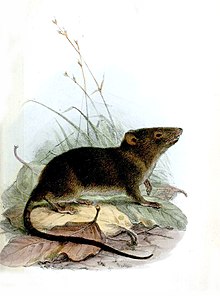The dusky caenolestid (Caenolestes fuliginosus), also known as Tate's shrew opossum,[2] is a shrew opossum from South America. The dusky caenolestid is characterized by a dark brown coat with a lighter underbelly, soft and thick fur, and a loosely haired tail. A nocturnal animal (active mainly at night), the dusky caenolestid lives on trees and feeds on insects and small invertebrates and vertebrates. It occurs in alpine and páramo forests in northern and western Colombia, Ecuador, and western Venezuela. The IUCN classifies this shrew opossum as least concern.
| Dusky caenolestid | |
|---|---|

| |
| Scientific classification | |
| Domain: | Eukaryota |
| Kingdom: | Animalia |
| Phylum: | Chordata |
| Class: | Mammalia |
| Infraclass: | Marsupialia |
| Order: | Paucituberculata |
| Family: | Caenolestidae |
| Genus: | Caenolestes |
| Species: | C. fuliginosus
|
| Binomial name | |
| Caenolestes fuliginosus (Tomes, 1863)
| |
| Subspecies | |
| |

| |
| Range of the dusky caenolestid | |
| Synonyms | |
|
Hyracodon fuliginosus (Tomes, 1863) | |
Taxonomy and etymology
editThe dusky caenolestid is one of the five members of Caenolestes, and is placed in the family Caenolestidae (shrew opossums). It was first described by English zoologist Robert Fisher Tomes as Hyracodon fuliginosus in 1863.[3] It was given its present binomial name by English zoologist Oldfield Thomas in 1895.[4] In the latter part of 20th century, scientists believed that Caenolestes is closely related to Lestoros (the Incan caenolestid).[5][6] Over the years, it became clear that Lestoros is morphologically different from Caenolestes.[4] A 2013 morphological and mitochondrial DNA-based phylogenetic study showed that the Incan caenolestid and the long-nosed caenolestid (Rhyncholestes raphanurus) form a clade sister to Caenolestes. The cladogram below is based on this study.[7]
| |||||||||||||||||||||||||||||||||||||||||||||||||
Three subspecies are recognized:[4]
- C. f. centralis Bublitz, 1987: Occurs in the Andean natural region (Colombia) and extreme west of Venezuela.
- C. f. fuliginosus (Tomes, 1863): Occurs in central Ecuador.
- C. f. obscurus Thomas, 1895: Occurs around Bogotá (Colombia).
Caenolestid fossils date to as early as the early Eocene (nearly 55 mya). The generic name Caenolestes derives from the Greek words kainos ("new") and lestes ("robber", "pirate").[8]
Description
editThe dusky caenolestid is characterized by a dark brown coat with a lighter underbelly, soft and thick fur, and a loosely haired tail. The head-and-body length is between 9.3 and 13.5 centimetres (3.7 and 5.3 in), the tail measures 9.3 to 12.7 centimetres (3.7 to 5.0 in) and hindfeet are 2.2 centimetres (0.87 in) long. The ears and eyes are smaller and the rostrum is longer than in other caenolestids.[9] The forefeet have five digits each; while two of them are blunt, the other three digits bear sharp claws. The toes of the hindfeet bear sharp claws as well, except for the biggest toe. There are four teats and no pouch.[10] A 2007 study recorded dental anomalies such as missing teeth and supernumerary teeth.[11]
Ecology and behavior
editThe dusky caenolestid is nocturnal (active mainly at night), and lives on trees. It can be a fast runner, like the Incan caenolestid, though it does not move in leaps and jumps. The dusky caenolestid is reported to have a poor vision, though its sense of smell and hearing are good.[10] Diet consists of lepidopteran larvae, insects, rodents, arachnids and centipedes; plant material may be eaten as well.[9] The tail, though prehensile, may not be able to support the animal when it hangs down a branch.[12]
Distribution and status
editThe dusky caenolestid inhabits alpine and páramo forests in northern and western Colombia, Ecuador, and western Venezuela. It can occur in an altitudinal range of 1,600–4,000 metres (5,200–13,100 ft) above the sea level. The IUCN classifies it as least concern given its wide distribution and presumably large numbers. The caenolestid faces competition from the wandering small-eared shrew, and is thus rare, in montane regions of Ecuador. Cattle grazing is a major factor in habitat degradation.[1]
References
edit- ^ a b Martin, G.M. (2016). "Caenolestes fuliginosus". IUCN Red List of Threatened Species. 2016: e.T41506A22179949. doi:10.2305/IUCN.UK.2016-2.RLTS.T41506A22179949.en. Retrieved 20 November 2021.
- ^ Barnett, A.A. (1991). "Records of the grey-bellied shrew opossum, Caenolestes caniventer and Tate's shrew opossum, Caenolestes tatei (Caenolestidae, Marsupialia), from Ecuadorian montane forests" (PDF). Mammalia. 55 (3): 443–5. doi:10.1515/mamm.1991.55.3.433.
- ^ Gardner, A.L. (2005). "Order Paucituberculata". In Wilson, D.E.; Reeder, D.M (eds.). Mammal Species of the World: A Taxonomic and Geographic Reference (3rd ed.). Johns Hopkins University Press. p. 19. ISBN 978-0-8018-8221-0. OCLC 62265494.
- ^ a b c Gardner, A.L., ed. (2007). Mammals of South America. Vol. 1. Chicago, US: University of Chicago Press. pp. 121, 124–6. ISBN 978-0-226-28242-8.
- ^ Simpson, G.G. (1970). "The Argyrolagidae, extinct South American marsupials". Bulletin of the Museum of Comparative Zoology. 139: 1–86.
- ^ Marshall, L.G. (1980). "Systematics of the South American marsupial family Caenolestidae". Fieldiana: Geology. New Series. 5: 1–145.
- ^ Ojala-Barbour, R.; Pinto, C.M.; Brito M., J.; Albuja V., L.; Lee, T.E.; Patterson, B.D. (2013). "A new species of shrew-opossum (Paucituberculata: Caenolestidae) with a phylogeny of extant caenolestids" (PDF). Journal of Mammalogy. 94 (5): 967–82. doi:10.1644/13-MAMM-A-018.1.
- ^ Patterson, B.D.; Gallardo, M.H. (1987). "Rhyncolestes raphanurus" (PDF). Mammalian Species. 286: 1–5. doi:10.2307/3503866. JSTOR 3503866.
- ^ a b Eisenberg, J.F.; Redford, K.H. (1999). The Central Neotropics: Ecuador, Peru, Bolivia, Brazil. Chicago, US: University of Chicago Press. p. 82. ISBN 978-0-226-19542-1.
- ^ a b Nowak, R.M. (2005). Walker's Marsupials of the World. Baltimore, US: Johns Hopkins University Press. pp. 87–8. ISBN 978-0-8018-8211-1.
- ^ Martin, G.M. (2007). "Dental anomalies in Dromiciops gliroides (Microbiotheria, Microbiotheriidae), Caenolestes fuliginosus and Rhyncholestes raphanurus (Paucituberculata, Caenolestidae)". Revista Chilena de Historia Natural. 80 (4): 393–406. doi:10.4067/S0716-078X2007000400001. hdl:11336/102947.
- ^ Hunsaker II, D., ed. (1977). The Biology of Marsupials. Oxford, UK: Elsevier. p. 108. ISBN 978-0-323-14620-3.
